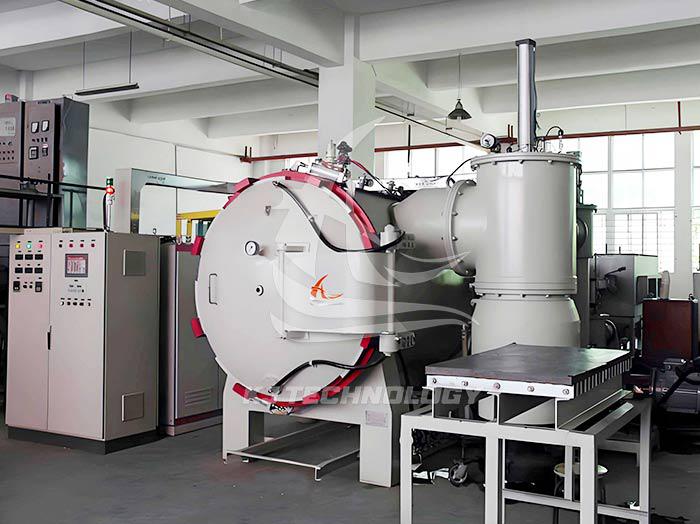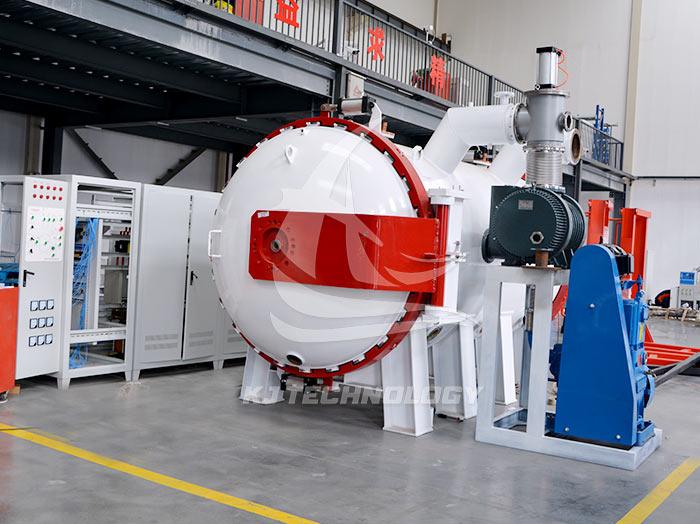High temperature vacuum brazing furnace ceramic brazing
 11-20-2025 Author: KJ technology
11-20-2025 Author: KJ technology
The application of high-temperature vacuum brazing furnace in the ceramic industry is extensive and critical, mainly reflected in the reliable connection between ceramics and metals. The following analysis is conducted from four dimensions: technical principles, application scenarios, technical advantages, and typical cases:
1. Technical principle: Precision welding in vacuum environment
The high-temperature vacuum brazing furnace heats the workpiece in a high vacuum (usually ≤ 10 ⁻ ³ Pa) or protective atmosphere to melt the brazing material and fill the joint gap, achieving metallurgical bonding between ceramics and metals. Its core advantages lie in:
Non oxidizing environment: Vacuum isolation of oxygen to prevent the formation of brittle oxide layers between ceramics and metals at high temperatures, ensuring joint performance.
Uniform thermal field: Through a precision temperature control system (temperature uniformity within ± 2 ℃), welding thermal stress is eliminated to prevent ceramic cracking or metal deformation.
Low residual stress: atomic diffusion is sufficient, joint structure is uniform, residual stress is lower than traditional welding, and reliability is improved.
2. Application scenario: Covering the entire chain of ceramic metal composite structures
Electronic Packaging and Thermal Management
AMB Ceramic Substrate: By using Active Metal Brazing (AMB) technology, copper foil is connected to ceramic substrates (such as Al ₂ O3, AlN) to form a composite structure with high thermal conductivity and insulation, which is widely used in high-power LED, IGBT modules, etc.
Microwave device packaging: Vacuum brazing achieves airtight packaging of microwave components to ensure stable electrical performance, used for 5G communication base station RF modules.
Aerospace and Energy
Hot end component connection: such as precision connection of cooling channels for aircraft engine turbine blades, using vacuum brazing of nickel based high-temperature alloys and ceramics to withstand extreme high temperatures and stresses.
Fuel cell bipolar plate: Developing specialized conductive brazing materials to reduce contact resistance and improve the performance and reliability of the fuel cell stack.
Medical Devices and Bioengineering
Orthopedic implants: Vacuum brazing of titanium alloy porous structure and ceramics, balancing biocompatibility and mechanical properties, used for artificial joint manufacturing.
Dental restoration: Low temperature vacuum brazing achieves high-strength connection between dental ceramics and metal substrates, solving the problem of traditional process cracks and improving the service life of restorations.
3. Technical advantage: Breaking through the limitations of traditional welding
Wide adaptability of materials
It can weld high melting point ceramics such as Al ₂ O ∝ and ZrO ₂ with metals such as stainless steel, aluminum alloys, and high-temperature alloys, and even achieve the connection between ceramics.
For example, vacuum brazing of Al ₂ O ∝ ceramics with 5005 aluminum alloy results in higher joint shear force; The shear strength of the joint between DD3 high-temperature alloy and Ti ∝ AlC ₂ ceramic increases.
High process precision
The temperature control curve can be precisely designed (such as segmented heating and gradient insulation) to adapt to different material combinations.
environmental protection and energy conservation
No need for soldering flux, no exhaust gas or wastewater discharge throughout the process, in compliance with environmental standards.
Efficient insulation design (such as multi-layer graphite felt insulation screen) reduces heat loss and is more energy-efficient than air furnaces.
4. Typical Case: From Laboratory to Industrialization Practice
Ceramic metal dissimilar material connection
Aluminum oxide ceramics and 304 stainless steel: Vacuum brazing is performed by metalizing the ceramic surface (molybdenum manganese slurry coating+1500 ℃ sintering infiltration+electroplating nickel plating) with nickel plated stainless steel, and the joint meets high-temperature testing with lower helium leakage rate.
SiO ₂ ceramics and copper: Ag Cu Ti active brazing material is used to achieve high-strength connection, and the shear strength reaches the industry-leading level.
High end equipment manufacturing
Spacecraft propulsion system: precision components of satellite thrusters are manufactured by vacuum brazing, and the deformation problem of thin-walled structures is solved through stepped heating technology to ensure the dimensional accuracy and sealing performance of the injector. It has been applied to multiple satellites.
Thermal management of new energy vehicles: vacuum brazed aluminum alloy heat pipes and heat dissipation fins, development of lightweight thermal control components, and improvement of thermal conductivity efficiency.
5. Future Trends: Intelligent and Customized Upgrades
Intelligent control
Integrated PLC+touch screen system, pre stored multiple process curves, enabling one click start and data traceability, reducing human error.
Digital twin technology predicts temperature field distribution through simulation, eliminates hot spot hazards in advance, and improves product yield.
customized design
Develop non-standard furnace and multi temperature zone control technology for irregular ceramic parts (such as curved surfaces and microporous structures) to meet personalized needs.
Modular design supports quick changeover and adapts to multi variety and small batch production modes.








